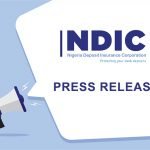The Nigeria Deposit Insurance Corporation (NDIC) has released its 2015 Annual Report. Below are the highlights of the report.
1.0 Following a study on coverage levels conducted by the NDIC in 2015, it reviewed upwards the coverage level for depositors of PMBs from N200,000 to N500,000 in 2015. The current coverage levels of N500,000 per depositor per DMB and N200,000 per depositor per MFB were found to be adequate and so remained unchanged.
1.1 The NDIC reduced the premium paid by banks by ₦9.09 billion in 2015 following the reduction of the premium base rate from 40 basis point to 35 for each DMB/NIB under the Differential Premium Assessment System (DPAS).
1.2 During the year under review, the Corporation extended deposit insurance coverage to subscribers of mobile money operators (MMOs) via the concept of pass-through deposit insurance up to a maximum of ₦500,000.
1.3 The NDIC, in collaboration with the CBN, conducted the routine Risk Assessment of all the 24 DMBs while the NDIC conducted risk-based examinations of 205 MFBs and 6 PMBs. The examinations were with a view to providing reliable information on their financial health particularly as it affects the quality of risk assets, adequacy of loan loss provisions, capital adequacy, their level of compliance with banking rules and regulations, risk appetite and adequacy of risk management frameworks.
1.4 The NDIC made a cumulative payment of ₦6.796 billion to 426,324 insured depositors of the closed DMBs as at 31st December, 2015 as against ₦6.795 billion to 426,320 insured depositors in 2014.
1.5 The NDIC made a cumulative payment of ₦2.86 billion to 81,328 depositors of the closed MFBs as at 31st December, 2015 as against N2.77 billion paid to 80,178 depositors in 2014. Also, the NDIC made a cumulative payment of N45.05 million to 595 depositors of closed PMBs as at 31st December, 2015 as against N2.02 million paid to 30 depositors in 2014.
1.6 The sum of N95.77 billion was paid as liquidation dividend to depositors of DMBs in 2015 compared to N94.74 billion as at December 31, 2014. That amount included the uninsured portion of private sector depositors of 11 out of the 13 banks closed post-bank consolidation which was funded by the CBN.
1.7 Similarly, the NDIC paid liquidation dividends to creditors of DMBs-in-liquidation in 2015 while the sum of N1,728.40 million was declared as dividends to 1,308 creditors of the ten DMBs. Out of that amount, the NDIC paid the sum of N1,261.73 million to the 965 creditors who filed their claims as at 31st December, 2015 as against N1,247.77 million paid to the 889 creditors as at 31st December, 2014.
1.8 During the year under review, the NDIC also paid ₦2.41 billion as total liquidation dividends to 550 shareholders of 6 DMBs-in-liquidation as at 31st December, 2015 as against N2.03 billion paid to 453 shareholders of DMBs-in-liquidation as at 31st December, 2014.
1.9 The cumulative amount of loans recovered over the years stood at N27.41 billion as at 31st December, 2015 compared with N26.75 billion as at 31st December, 2014. Similarly, the cumulative risk assets recovered from closed MFBs amounted to N125.61 million as at 31st December, 2015 compared with N124.38 million as at 31st December, 2014 while the debt recoveries from the debtors of PMBs in-liquidation amounted to ₦24.73 million as at 31st December, 2015.
1.10 The NDIC sponsored several corporate and community-based events which were aimed at promoting its visibility and presence in the public domain. Some of these projects were education-support and community health care related. In 2015, the NDIC spent the sum of N236.15 million on eighteen (18) projects spread across the country.
1.11 The NDIC also complied with the provisions of the Fiscal Responsibility Act in 2015 and remitted the sum of ₦24,185,762,000 to the Consolidated Revenue Fund of the Federation in 2015 as against N15.38 billion in the previous year. The NDIC’s operating surplus for 2015 stood at N30.23 billion as against N15.52 billion in 2014.
2.0 FINANCIAL CONDITION OF DEPOSIT MONEY BANKS
The banking industry total assets grew marginally by 1.36%, total loans and advances rose by 5.56%, shareholders’ funds unimpaired by losses increased by 14.02% while capital adequacy ratio stood at 17.66%. However, total deposit liabilities declined by 2.83%, unaudited profits decreased by 2.02% while non-performing loans increased by 82.87% in 2015.
2.1 Capital Adequacy: The banking industry capital base remained strong. The capital adequacy ratio (CAR) of the banking industry was 17.66% in 2015 compared with 15.92% in 2014, but exceeded the minimum threshold of 10% and 15% for national and international banks respectively. Two (2) DMBs had CAR below the prescribed threshold of 10% in 2015.
2.2 Asset Quality: Total loans and advances to the Nigerian economy stood at ₦13.33 trillion in 2015, showing an increase of 5.56% over the ₦12.63 trillion reported in 2014. The non-performing loans to total loans ratio for the industry increased from 2.81% in 2014 to 4.87% in 2015, but was within the regulatory threshold of 5%.
2.3 Earnings and Profitability: The banking industry operated profitably, though earnings and profitability deteriorated. The unaudited profit-before-tax (PBT) of the banking industry stood at ₦588.86 billion as at 31st December, 2015 representing a decrease of 2.02% over ₦601.02 billion reported as at 31st December, 2014.
2.4 Liquidity Management: The banking industry’s liquidity position was strong as its average liquidity ratio rose slightly from 53.65% in 2014 to 58.18% in 2015. All the individual DMBs had liquidity ratios above the prudential minimum threshold of 30% as at 31st December, 2015.
2.5 Level of Soundness of DMBs in 2015
Overall, the banking industry remained stable and sound during the period under review.
3.0 FINANCIAL CONDITION OF MICROFINANCE BANKS (MFBS)
3.1 Capital Adequacy: The MFBs paid-up capital increased by 54.40% from ₦54.52 billion in 2014 to ₦84.18 billion in 2015. The MFBs had average CAR of 43.75% as at 31st December, 2015.
3.2 Asset Quality: Total loans and advances increased by 46.34% from ₦114.70 billion in 2014 to ₦167.85 billion in 2015. The quality of risk assets deteriorated further as the NPL increased from 18.54% in 2014 to 23.13% in 2015, which exceeded the prudential maximum threshold of 5%.
3.3 Earnings and Profitability: Unaudited Profit before tax decreased by 77.63% from ₦7.51 billion in 2014 to ₦1.68 billion in 2015. Also, return on assets (ROA) and return on equity (ROE) for the subsector declined from 3.39% and 14.70% in 2014 to 0.47% and 13.74% in 2015, respectively.
3.4 Liquidity Management: The liquidity position of the microfinance subsector was strong as average liquidity ratio rose from 80.37% in 2014 to 119% in 2015 and compared favourably with the minimum prudential threshold of 20%.
3.5 Overall, the performance of the MFB subsector improved compared to the previous year as they had strong capital base and liquidity.
4.0 FINANCIAL CONDITION OF PRIMARY MORTGAGE BANKS
4.1 Out of 42 PMBs in operation, a total of 14 failed to render returns to the NDIC and unpaid premium from nine (9) PMBs amounted to N238.30 million in 2015.
4.2 Capital Adequacy: The PMBs shareholders’ funds increased by 93.91% to N138.92 billion in 2015 from N71.64 billion in 2014. The subsector CAR was 74.04% as at December 2015 which exceeded the prudential threshold of 10%.
4.3 Asset Quality: Total loans and advances extended by the subsector declined significantly by 31.87% to N168.96 billion in 2015. There was a significant improvement in the quality of assets as the NPL ratio decreased from 44.14% in 2014 to 15.40% in 2015. Despite that improvement, the NPL ratio of 15.40% exceeded the prudential maximum threshold of 5%.
4.4 Earnings & Profitability: Unaudited Profit before tax rose from N2.79 billion in 2014 to N3.31 billion in 2015 due to significant rise in interest income and non-interest income by 90.75% and 321.05% in 2015, respectively.
4.5 Liquidity: The PMBs liquidity position was strong during the period under review as the average liquidity ratio was 72.63% in 2015 as against 80.37% in the previous year and exceeded the prudential minimum threshold of 20%.
4.6 Overall, the performance of the PMB subsector improved in almost all indices in comparison with 2014. The improvement in the operations of the PMBs was due to the recapitalisation of the sector, enhanced compliance by PMB operators and improved supervisory oversight.
5.0 FRAUDS AND FORGERIES
5.1 A total of 12,279 fraud cases were reported, representing an increase of 15.71% over the 10,612 fraud cases reported in 2014. However, the amount involved decreased significantly by N7.59 billion or 29.63% from N25.608 billion in 2014 to N18.021 billion in 2015. Similarly, the actual loss suffered by the insured banks decreased by N3.02 billion or 48.79% from N6.19 billion in 2014 to N3.17 billion in 2015.
5.2 The actual loss sustained in respect of internet banking fraud was N857 million, representing 27% of total actual loss of the industry. There was an increase in the frequency of ATM/Card-Related Fraud cases from 7,181 in 2014 to 8,039 in 2015, an increase of 11.95%. However, the loss suffered by the industry due to such frauds declined significantly by 59.4% from previous year figure of ₦1.242 billion to ₦0.504 billion, representing 15.9% of total industry loss to frauds and forgeries.
5.3 Out of the 12,279 fraud cases reported by the DMBs, 425 cases were attributed to staff. The number of fraud cases perpetrated by staff had decreased from 465 in 2014 to 425 in 2015. Similarly, losses arising therefrom substantially decreased by 70% from N3.165 billion in 2014 to ₦0.979 billion in 2015. The highest percentage of frauds and forgeries cases of 38.59% was perpetrated by temporary staff.
6.0 SUSTAINABLE BANKING
The NDIC remained committed to the implementation of the Sustainability Principles. A Sustainable Banking Desk was set up in the Managing Director’s Office and an Implementation Committee was established to work with Sustainable Banking Champions to ensure continuous sensitization and awareness.
The Corporation has embarked on sustained and continuous capacity building programmes for staff on environmental and social risks issues. It also collaborates with other stakeholders to promote and expand the Sustainable banking space.
MANAGEMENT
JUNE 2016



